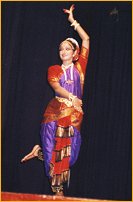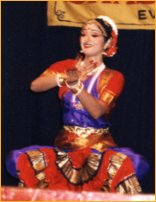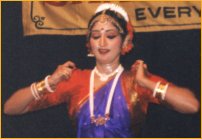The
Kanaka Sabha, an institution in Chembur, Mumbai, dedicated for nearly two
decades to the promotion of Bharatanatyam and Kuchipudi under the direction
of Dr Siri Rama and Smt Saroja Srinath, presented one of its star disciples,
Kum Rumya, at a concert at the prestigious auditorium of the International
Society for Krishna Consciousness (ISKCON) in Juhu, Mumbai, in the
afternoon of December 8, 2002 The ISKCON is visited by a large number
of devotees, both from India and abroad. Keeping the multi-lingual
and multi-racial composition of the potential audience, Dr Siri Rama and
Kum Rumya had planned their repertoire in an imaginative way. The emphasis
was on moving quickly from one item to another so that the various facets
of Bharatanatyam could be presented in a capsule, so to say, without in
any way detracting from depth in content or classicism. Thus there were
seven items presented in the course of an hour. As could be expected, the
emphasis was on the Krishna theme. The artiste, endowed with the personality
of a dancer to the manner born, exhibited joie de vivre throughout
the programme unmindful of the small size of the audience.
She holds a Master’s degree in Clinical Psychology and works with handicapped
children. She is no novice to the art form. She had her arangetram
a decade ago and since then has participated in many dance dramas of Kanaka
Sabha (Hayavadana, The Fifth Lotus, Padmavati Kalyanam, etc.) in
Hong Kong and Singapore besides in India.
| The concert
started with a Pushpanjali in Nattai, the traditional invocatory piece.
It was. followed by a Purandaradasar song (“Neene Anathabandhu”)
presented as a Padam in Gurjari Todi. The two episodes relating to Krishna
as Vitthala and his rescue of Gajendra were portrayed brimming with bhakti.
Since there was no scope for a heavy item like Varnam to be presented,
given the nature of the audience, this Padam effectively substituted for
it in exploring sanchari bhavas and other aesthetic elements. Then
came the centre-piece of Ashtalakshmi composed by Madurai Muralidharan
in Ragamalikai. The various aspects of Lakshmi as one who grants the boon
of victory, prosperity, happiness, etc., were brought out in
a fast-paced rendition of charanams studded with sparkling
chittaswarams. Next was a Meera bhajan (“Jhoolatha Radha”)
in Yaman Kalyani. The madhura bhava bhakti of Radha was brought
out well. Meera describes how Krishna and Radha experienced the joys
of the spring season. It is often humorously said that Mumbai has only
two seasons – the hot and the hotter. One, however, saw the
spring season on the stage. The swinging of the jhoola was very
realistic. “Enna Tavam” - a well-known song of Papanasam Sivan
in Kapi – followed. In describing the fortune of Yashoda in playing mother
to Lord Krishna, full advantage was taken for sanchari bhavas depicting
the myriad leelas of the god. The penultimate piece was Balamurali Krishna’s
tillana in Kathanakuthoohalam, popular both on the music and dance
stages. The nritta was done with beautiful sculptural poses associated
with this form of dance. As a climax Rumya danced to the tune of “Krishna
Nee Begane Baro”. No, it was not the well-known Kanakadasa song. It
was a composition of the Colonial Cousins, who had taken only the first
four words from the popular number. It was an ode to peace in English requesting
Lord Krishna to come down to earth and resolve the conflicts of the world.
Easily it was the piece-de-resistance of the programme. It showed
how much scope there is in Bharatanatyam for innovation without violating
the norms of the sastras. This writer was impressed by the manner
in which Jesus Christ, the son of God, was represented – a contribution
supplementing the Devata hastalakshanas in the sastras. |


|
The dance was
performed to the accompaniment of recorded music. A live orchestra would
have no doubt enhanced its appeal. As the attention of the audience
was riveted on the artiste’s magnificent performance, perhaps it was not
missed. However, one should acknowledge the rich melody and rhythm of the
artistes who had recorded for the event. The popular dancer-cum-compere,
Kum Vidya, introduced each item in a brief but effective manner.
Summing up,
Rumya’s recital was representative of a standard classical Bharatanatyam
programme. Attractive and fault-free adavus marked her dance. This
reviewer noted her ability to sit on the floor and get up artistically
without a jerk, the bane of many dancers. The costumes were sober and did
not distract attention. My only critical comment is that there were no
variations in tala, all the items being in Adi. Perhaps this
was justified, considering that the audience was expected to consist of
laymen, not connoisseurs, who would not have been able to distinguish
between one tala and another or their role in imparting the
rasas.
A Seshan is
an Economic Consultant in Mumbai, formerly Officer-in-Charge of the Department
of Economic Analysis and Policy in the Reserve Bank of India. He is a music
and dance enthusiast and writer. |


